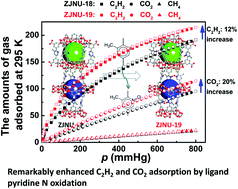Immobilization of N-oxide functionality into NbO-type MOFs for significantly enhanced C2H2/CH4 and CO2/CH4 separations†
Abstract
NbO-type MOFs built up from linear diisophthalate ligands and dicopper paddlewheel-based secondary building units offer an excellent platform to perform pore surface chemistry engineering and understand the structure–property relationship. In this work, we designed and synthesized two N-oxide functionalized linear diisophthalate ligands, and employed them to construct under suitable solvothermal conditions their corresponding NbO-type MOFs termed ZJNU-19 and ZJNU-20. Their gas adsorption properties with respect to C2H2, CO2, and CH4 were systematically measured, and adsorption selectivities of C2H2 and CO2 over CH4 were assayed using a well-known ideal adsorbed solution theory, establishing their promising potential for C2H2/CH4 and CO2/CH4 separations in connection with acetylene and natural gas separation and purification, which were found to be less dependent on the methyl position. In particular, at atmospheric pressure, the C2H2 and CO2 uptake capacities reach as high as 214.5 and 114.7 cm3 (STP) g−1 for ZJNU-19, and 210.0 and 111.9 cm3 (STP) g−1 for ZJNU-20 at 295 K, while the IAST-predicted C2H2/CH4 (v/v = 1/1) and CO2/CH4 (v/v = 1/1) adsorption selectivities are up to 42.2 and 6.4 for ZJNU-19, and 42.1 and 6.2 for ZJNU-20 at 298 K. Furthermore, a comparative investigation demonstrated that N-oxide is a powerful chemical functionality that can be utilized to design and construct porous framework compounds for boosting C2H2 and CO2 adsorptions.



 Please wait while we load your content...
Please wait while we load your content...